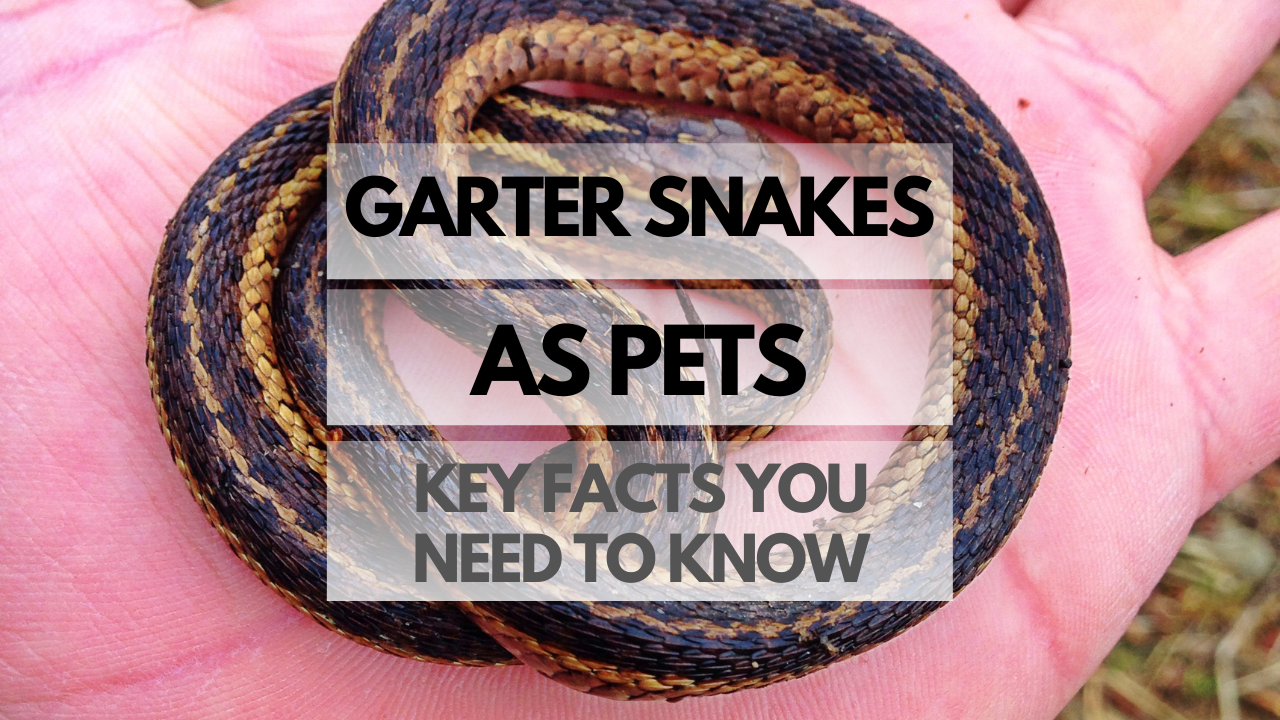Garter Snakes have been popular pets for decades due to their small size, manageable care requirements, and striking appearance. These fascinating reptiles can be found throughout North America, making them accessible and well-known to many people. In this article, we’ll discuss everything you need to know about Garter Snakes as pets, from their behavior and temperament to their care and feeding.
Quick Reference Table: Garter Snake Facts
| Fact | Details |
|---|---|
| Scientific Name | Thamnophis spp. |
| Size | 18-54 inches (45-137 cm) |
| Lifespan | 5-10 years in captivity |
| Behavior | Docile, active, and relatively easy to handle |
| Temperament | Friendly and curious, with occasional skittishness |
| Diet | Earthworms, fish, amphibians, and some rodents |
| Native Habitat | North America, from Canada to Central America |
How Are Garter Snakes as Pets?
Garter Snakes make excellent pets, particularly for beginners or those with limited space. They are generally docile, easy to handle, and have relatively simple care requirements, making them ideal for first-time reptile owners.
Pros and Cons of Garter Snakes
Pros:
- Small size, ideal for limited space
- Easy to care for and maintain
- Docile and easy to handle
- Attractive appearance
- Relatively inexpensive
Cons:
- Can be skittish and prone to escape
- May require live or frozen/thawed prey
- Some species may emit a musk when frightened
Garter Snake Behavior and Temperament
Garter Snakes are generally friendly and curious creatures, although they can be a bit skittish at times. With regular handling and positive reinforcement, they usually become more comfortable and calmer over time.
How Much Do Garter Snakes Cost?
Garter Snakes themselves typically cost between $20-$100, depending on the species and color morph. Initial setup costs for their enclosure, heating, lighting, and other necessities can range from $100-$300. Ongoing expenses include food, substrate, and occasional replacements for equipment.
Garter Snake Lifespan: Time and Commitment
Garter Snakes have a life expectancy of 5-10 years in captivity with proper care. Owning a Garter Snake requires a commitment to their care and wellbeing, including regular feeding, cleaning, and habitat maintenance.
Garter Snake Size
Garter Snakes typically range from 18 to 54 inches (45 to 137 cm) in length, depending on the species and sex of the snake.
Garter Snake Species
Eastern Garter Snake (Thamnophis sirtalis sirtalis)
One of the most common species, the Eastern Garter Snake is known for its distinctive yellow or orange stripe down its back.
Western Terrestrial Garter Snake (Thamnophis elegans)
Found in the western United States, these snakes have a variety of color patterns and can be quite striking in appearance.
Checkered Garter Snake (Thamnophis marcianus)
Known for its bold, checkered pattern, the Checkered Garter Snake is native to the southern United States and Mexico.
Garter Snake Colors, Looks, and Appearances
Garter Snakes come in a wide variety of colors and patterns, including stripes, checkered patterns, and solid colors. Some of the most common colors include green, brown, black, yellow, and red. Many Garter Snakes also have a distinctive, longitudinal stripe running down their back.
Garter Snake Care Guide
Caring for your Garter Snake involves providing a suitable habitat, proper nutrition, and maintaining a clean and healthy environment. With the right care, your Garter Snake will thrive and become a fascinating, low-maintenance pet.
Garter Snake Habitat: Tank and Housing
Appropriate Garter Snake Tank Size
A minimum tank size of 20 gallons is recommended for a single Garter Snake, with larger tanks needed for multiple snakes or larger species. Ensure the enclosure has a secure lid to prevent escapes.
Types of Enclosures
Glass terrariums, plastic enclosures, or modified aquariums with good ventilation can all be used to house Garter Snakes. The most important factor is that the enclosure is secure and escape-proof.
Substrate Options
Popular substrate choices include aspen shavings, cypress mulch, or coconut coir. Avoid using cedar or pine shavings, as they can be harmful to snakes.
Heating and Lighting Requirements
Provide a heat gradient in the enclosure, with a basking area of around 85-90°F (29-32°C) and a cooler area around 70-75°F (21-24°C). A basking light or under-tank heater can be used for heating. UVB lighting is not necessary, but can be beneficial for your snake’s overall health.
Humidity and Temperature Control
Maintain a humidity level of 40-60% in the enclosure. This can be achieved through regular misting, a water dish, or a humidity box. Monitor humidity and temperature levels with a hygrometer and thermometer to ensure a suitable environment.
Furnishings and Decorations
Provide hiding spots, such as cork bark, half-logs, or commercial reptile hides. Climbing branches and plants, either real or artificial, can be added for enrichment and to create a more natural environment.
Cleaning and Maintenance
Spot clean the enclosure daily, removing any waste or uneaten food. Replace the substrate and thoroughly clean the entire enclosure every 4-6 weeks, or as needed.
Garter Snake Food: Diet and Nutrition
Feeding Frequency and Schedule
Feed juvenile Garter Snakes every 3-5 days, and adults every 7-10 days, adjusting the frequency according to your snake’s size and activity level.
What do Garter Snakes Eat?
Garter Snakes primarily eat earthworms, fish, amphibians, and occasionally small rodents. Prey items should be appropriately sized for the snake, no larger than the widest part of its body.
Garter Snake Treats
Occasionally, you can offer your Garter Snake small pieces of lean, cooked meat (e.g., chicken or turkey) as a treat.
Foods to Avoid
Avoid feeding your Garter Snake insects, as they are not a natural part of their diet and can cause health issues.
Supplements and Vitamins
Vitamin and mineral supplements are not typically necessary for Garter Snakes, as long as they are fed a varied and balanced diet.
Hydration
Provide a shallow water dish in the enclosure for your Garter Snake to drink from and occasionally soak in. Change the water daily and keep the dish clean.
Handling and Socialization
Taming and Bonding
With consistent, gentle handling, Garter Snakes can become comfortable with their human caretakers. Start by handling your snake for short sessions, gradually increasing the duration over time. Be patient and avoid sudden movements, as this can startle the snake.
Safe Handling Techniques
When handling your Garter Snake, use both hands to support its body, allowing the snake to move freely without feeling restrained. Avoid gripping the snake tightly or handling it by the tail, as this can cause injury or stress.
Signs of Stress and Illness
Signs of stress in Garter Snakes can include excessive hiding, refusal to eat, and increased aggression. If you notice any of these symptoms, reassess your snake’s environment and care to determine the cause and make necessary adjustments.
Introducing Garter Snakes to Other Pets
Introducing Garter Snakes to other pets should be done cautiously and under supervision. Keep in mind that some pets, such as cats and dogs, may pose a threat to your snake, so always be vigilant during interactions.
Health and Wellness
Common Health Issues
Some common health issues in Garter Snakes include respiratory infections, parasites, skin infections, and mouth rot. Regular check-ups with a reptile veterinarian can help catch and treat these issues early.
Signs of a Healthy Garter Snake
A healthy Garter Snake will have clear eyes, smooth and well-fitting scales, a strong appetite, and an active, alert demeanor. If you notice any changes in your snake’s appearance or behavior, consult your reptile veterinarian.
Preventative Care
Regular enclosure maintenance, proper nutrition, and correct temperature and humidity levels are crucial to keeping your Garter Snake healthy. Monitor your snake’s health regularly and consult a veterinarian if you have any concerns.
Finding a Reptile Veterinarian
Locate a reptile veterinarian experienced in treating Garter Snakes before you bring your snake home. Establishing a relationship with a qualified vet will ensure that your pet receives the best possible care throughout its life.
Breeding and Reproduction
Determining Gender
Male and female Garter Snakes can be difficult to distinguish, but males typically have longer and more slender tails, while females have shorter, thicker tails.
Mating Behavior and Courtship
During mating season, male Garter Snakes will court females by rubbing their bodies against the female and flicking their tongue. If receptive, the female will allow the male to mate with her.
Gravidity and Egg-laying
Garter Snakes are ovoviviparous, meaning they give birth to live young rather than laying eggs. Gravid females will become noticeably thicker in the middle and may eat less or bask more frequently.
Incubation and Hatching
As Garter Snakes give birth to live young, there is no incubation period. The female will give birth to 10-40 baby snakes, depending on her size and species.
Caring for Hatchlings
After birth, baby Garter Snakes are independent and require no parental care. They should be separated from the mother and housed individually or in small groups to minimize stress and competition for resources.
Are Garter Snakes Legal?
While Garter Snakes are legal to keep as pets in most areas, some regions may have restrictions or require permits. Always check your local laws and regulations before acquiring a Garter Snake as a pet.
Popular Names for Garter Snakes
Choosing a fun and interesting name for your Garter Snake can be a great way to bond with your new pet. Some popular names include Stripe, Slippy, Checkers, Noodle, Ziggy, and Slinky.
Conclusion: Should You Own Garter Snakes as Pets?
If you’re prepared to provide the proper care and commitment, owning a Garter Snake can be a rewarding and fascinating experience. These low-maintenance reptiles make excellent pets for beginners and experienced keepers alike. By ensuring responsible ownership and a healthy, safe environment, your Garter Snake can thrive and bring enjoyment for years to come.
FAQ for Pet Garter Snakes
- Q: Are Garter Snakes good pets?
- A: Yes, Garter Snakes can make excellent pets due to their relatively low maintenance and gentle nature, making them suitable for beginners and experienced reptile keepers alike.
- Q: Can Garter Snakes eat grapes, bananas, strawberries, apples, spinach, tomatoes, carrots, cucumbers, watermelon, broccoli, blueberries, celery, cabbage, cilantro, kale, blackberries, oranges, avocados, corn, or asparagus?
- A: Garter Snakes are primarily carnivorous, so their diet should consist of small prey items like earthworms, fish, and amphibians. While they may eat some fruits and vegetables on rare occasions, these should not be a primary part of their diet.
- Q: How often do Garter Snakes eat?
- A: Garter Snakes typically eat every few days to a week, depending on their size and age. Younger snakes may need to eat more frequently than adults.
- Q: How long do Garter Snakes live?
- A: In captivity, Garter Snakes can live for 8-12 years with proper care and a healthy environment.
- Q: Where are Garter Snakes native?
- A: Garter Snakes are native to North America and can be found throughout the United States, Canada, and Mexico.
- Q: Are Garter Snakes friendly?
- A: Garter Snakes are generally docile and, with regular handling, can become comfortable with their human caretakers.
- Q: Do Garter Snakes bite?
- A: While Garter Snakes are not typically aggressive, they may bite if they feel threatened or stressed. Most bites are mild and pose little risk to humans.
- Q: Do Garter Snakes like to be held?
- A: Garter Snakes can become accustomed to handling with consistent, gentle interaction. They may not actively seek out human contact but can become comfortable being held.
- Q: Are Garter Snakes nocturnal?
- A: Garter Snakes are primarily diurnal, meaning they are active during the day and rest at night.
- Q: Do Garter Snakes pee?
- A: Yes, Garter Snakes excrete waste through a single opening called the cloaca, which includes both solid and liquid waste.
- Q: Do Garter Snakes hibernate?
- A: Garter Snakes in the wild may undergo a period of brumation, a hibernation-like state, during colder months. In captivity, this is not necessary, and with proper temperature control, they can remain active year-round.
- Q: Do Garter Snakes make noise?
- A: Garter Snakes are generally quiet, but they may hiss if they feel threatened or stressed.
- Q: Are Garter Snakes venomous or poisonous?
- A: Garter Snakes are mildly venomous but pose little to no risk to humans, as their venom is only effective on small prey items.
- Q: Are Garter Snakes smart?
- A: Garter Snakes have basic problem-solving and learning capabilities but are not considered particularly intelligent compared to some other animal species.
- Q: Do Garter Snakes need heat at night?
- A: Garter Snakes require a consistent temperature in their enclosure, including at night. A heat source, such as a heat pad or ceramic heat emitter, can help maintain the appropriate temperature.
- Q: Do Garter Snakes lay eggs?
- A: Garter Snakes are ovoviviparous, meaning they give birth to live young rather than laying eggs.
- Q: Do Garter Snakes smell?
- A: Garter Snakes themselves do not have a strong odor, but their waste can smell if not cleaned regularly. Maintaining a clean enclosure is essential to minimize odors.




